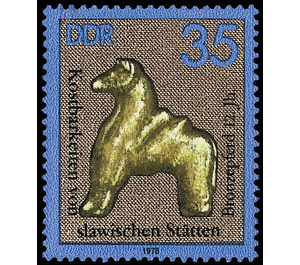Treasures of Slavic sites - Germany / German Democratic Republic 1978 - 35 Pfennig
Theme: Devices, Items & Instruments
| Country | Germany / German Democratic Republic |
| Issue Date | 1978 |
| Face Value | 35.00 |
| Color | brown |
| Perforation | K 14 |
| Printing Type | Rotogravure 2 |
| Stamp Type | Postage stamp |
| Item Type | Stamp |
| Chronological Issue Number | 2048 |
| Chronological Chapter | GER-DDR |
| SID | 24580 |
| In 20 Wishlists | |
Treasures of Slavic Sites With the depictions of treasures of Slavic sites, the Ministry of Posts and Telecommunications of the German Democratic Republic issues five multicolored special postage stamps. Special cancellations from February 21 to April 20, 1978 Treasures of Slavic sites in the German Democratic Republic The special postage stamp issue "Valuables of Slavic Sites" introduces historically remarkable objects from the Slavic era. The motifs were selected from the collections of various museums in the GDR. Slavic tribes and peoples inhabited the almost depopulated area between the Elbe, Saale and Oder / Neisse rivers since the 6th and 7th centuries. Their own development was hampered by war and raids of neighboring feudal states, especially German feudal lords, and later suffocated. The Slavic war of independence ended in the 12th century with the incorporation into the early feudal German state. Thus, the Slavs have a significant economic-cultural and political share in the historical process of the formation of the German people. Testimony to this intensive Slavic settlement are u. a. our present place names, of which at least half are of Slavic origin, many landscape names (eg Lusatia, Lubusz, Lommatzsch, Prignitz, Rügen) and 600 to 700 still preserved "castle ramparts". The Slavic culture had reached a considerable level and relied on skilled craft branches (eg in pottery and woodworking). On the basis of a broad folk art creation, an independent handicraft was created, which satisfied the demand for jewelery made of non-ferrous and precious metal. On several occasions crafts and trade were already concentrated in early urban settlements. Among the best known West Slavic tribes and peoples were the Obotrites and Wilzen (also called Lutizen) in eastern and western Mecklenburg, the Heveller in Havel Spree area and the Sorbs in the south of the German Democratic Republic, the only their linguistic and cultural characteristics received to the present. 35 Pfennig value: Bronze Horse Bronze Horse of the 12th century from Brandenburg City (3.3 cm high). The dark to red-brown saddled horse figure was recovered during excavations in 1966 on Dom Island and interpreted as children's toys. Brandenburg is already mentioned in 928/29 as a tribal center of Heveller and finally came after 200 years of fighting in 1157 in German possession. The small sculpture is located in the Museum of Prehistory and Early History Potsdam.


